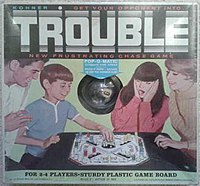
Ludo is a strategy board game for two to four players, in which the players race their four tokens from start to finish according to the rolls of a single die. Like other cross and circle games, Ludo is derived from the Indian game Pachisi. The game and its variations are popular in many countries and under various names.
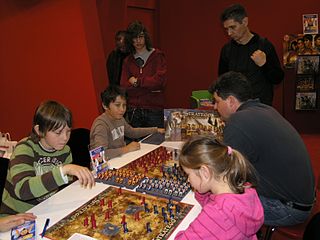
Stratego is a strategy board game for two players on a board of 10×10 squares. Each player controls 40 pieces representing individual officer and soldier ranks in an army. The pieces have Napoleonic insignia. The objective of the game is to either find and capture the opponent's Flag or to capture so many enemy pieces that the opponent cannot make any further moves. Stratego has simple enough rules for young children to play but a depth of strategy that is also appealing to adults.
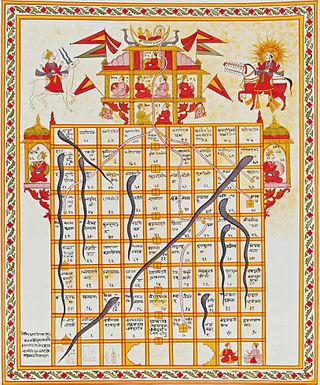
Snakes and ladders is a board game for two or more players regarded today as a worldwide classic. The game originated in ancient India as Moksha Patam, and was brought to the United Kingdom in the 1890s. It is played on a game board with numbered, gridded squares. A number of "ladders" and "snakes" are pictured on the board, each connecting two specific board squares. The object of the game is to navigate one's game piece, according to die rolls, from the start to the finish, helped by climbing ladders but hindered by falling down snakes.

Scotland Yard is a board game in which a team of players controlling different detectives cooperate to track down a player controlling a criminal as they move around a board representing the streets of London. It was first published in 1983. It is named after Scotland Yard which is the headquarters of London's Metropolitan Police Service in real-life. Scotland Yard is an asymmetric board game, during which the detective players cooperatively solve a variant of the pursuit–evasion problem. The game is published by Ravensburger in most of Europe and Canada and by Milton Bradley in the United States. It received the Spiel des Jahres award in 1983-the same year that it was published.
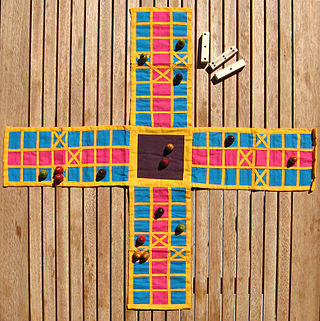
Pachisi is a cross and circle board game that originated in Ancient India. It is described in the ancient text Mahabharata under the name of "Pasha". It is played on a board shaped like a symmetrical cross. A player's pieces move around the board based upon a throw of six or seven cowrie shells, with the number of shells resting with the aperture upward indicating the number of spaces to move.

Battleship is a strategy type guessing game for two players. It is played on ruled grids on which each player's fleet of warships are marked. The locations of the fleets are concealed from the other player. Players alternate turns calling "shots" at the other player's ships, and the objective of the game is to destroy the opposing player's fleet.

Parqués is the Colombian version of a board game in the cross and circle family. The game is described as a "random thinking" game: the moves depend on the roll of the dice but players must consider possible strategies before executing their move. The objective of the game is to advance all the pieces to the end. Once in the safety zone player can use 2 dice until they are one space away from home, where they will then just use one die.

Parcheesi is a brand-name American adaptation of the Indian cross and circle board game Pachisi, published by Selchow & Righter and Winning Moves Games USA.

Connect Four is a game in which the players choose a color and then take turns dropping colored tokens into a six-row, seven-column vertically suspended grid. The pieces fall straight down, occupying the lowest available space within the column. The objective of the game is to be the first to form a horizontal, vertical, or diagonal line of four of one's own tokens. It is therefore a type of M,n,k-game with restricted piece placement. Connect Four is a solved game. The first player can always win by playing the right moves.

Tabletop games or tabletops are games that are normally played on a table or other flat surface, such as board games, card games, dice games, miniature wargames, or tile-based games.

Mensch ärgere Dich nicht is a German board game, developed by Josef Friedrich Schmidt in 1907/1908. Some 70 million copies have been sold since its introduction in 1914 and it is played in many European countries.

Perfection is a game originally produced by the Pennsylvania company Reed Toys and then by the Milton Bradley company. The object is to put all the pieces into matching holes on the board before the time limit runs out. When time runs out, the board springs up, causing many, if not all, of the pieces to fly out. In the most common version, there are 25 pieces to be placed into a 5×5 grid within 60 seconds.
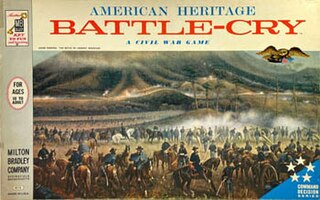
Battle-Cry is a combat board game set in the American Civil War that was published by the Milton Bradley Company in 1961 as part of their popular American Heritage series.

Aeroplane chess is a Chinese cross-and-circle board game similar to the Western game of Ludo and the Indian game of Pachisi. Developed in the 20th century, aeroplane chess features airplanes as pieces instead of the more abstract pawns and beehive-shaped pieces found in the games from which it is derived. Aeroplane chess has spread around the world, especially in Africa.
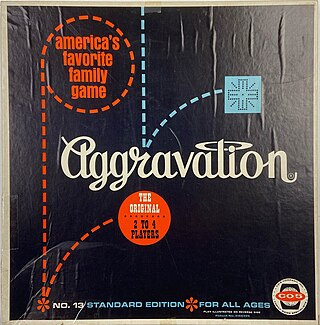
Aggravation is a board game for up to four players and later versions for up to six players, whose object is to be the first player to have all four playing pieces reach the player's home section of the board. The game's name comes from the action of capturing an opponent's piece by landing on its space, which is known as "aggravating". The name was coined by one of the creators, Louis Elaine, who did not always enjoy defeat.

Mall Madness is a shopping themed board game released by Milton Bradley in 1988.
Race game is a large category of board games, in which the object is to be the first to move all one's pieces to the end of a track. This is both the earliest type of board game known, with implements and representations dating back to at least the 3rd millennium BC in Egypt, Iraq, and Iran; and also the most widely dispersed: "all cultures that have games at all have race games". Race games often use dice to decide game options and how far to move pieces.

Coppit is a running-fight board game created in 1927 by Otto Maier Verlag which was originally called in German: Fang den Hut. It was renamed and has been re-released several times, most notably by the Spear's Games company in 1964. It is a game for two to six players and is based partly on luck with a die and partly on strategy. It is similar to the game Ludo and is nominally a children's game. The emblem on U-995, the world's only remaining German Type VIIC/41 submarine, features two Fang den Hut characters, as seen on the game's board.

Kimble is a Finnish licensed version of the board game Trouble in which players compete to be the first to send four pieces all the way around a board. Pieces are moved according to the roll of a die. Kimble is manufactured by Tactic Games Group and currently sold under the Tactic brand.
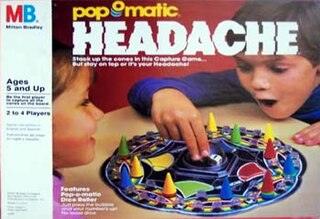
Headache is a board game in which two to four players take turns moving cone-shaped pieces around a board until one player succeeds in capturing every other piece on the board.
